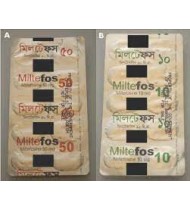Miltefosine
Indications
Miltefosine is an antileishmanial drug indicated in adults and adolescents ≥12 years of age weighing ≥30 kg (66 lbs) for treatment of:
- Visceral leishmaniasis due to Leishmania donovani.
- Cutaneous leishmaniasis due to Leishmania braziliensis, Leishmania guyanensis, and Leishmania panamensis.
- Mucosal leishmaniasis due to Leishmania braziliensis.
Pharmacology
Miltefosine has demonstrated activity against Leishmania parasites and neoplastic cells primarily due to its effects on apoptosis and disturbance of lipid-dependent cell signalling pathways. Several potential antileishmanial mechanisms of action have been proposed, however no mechanism has been identified definitely. Within the mitochondria, miltefosine inhibits cytochrome-c oxidase leading to mitochondrial dysfunction and apoptosis-like cell death. Antineoplastic mechanisms of action are related to antileishmanial targets and include inhibition of phosphatidylcholine biosynthesis and inhibition of Akt (also known as protein kinase B), which is a crucial protein within the PI3K/Akt/mTOR intracellular signalling pathway involved in regulating the cell cycle. Animal studies also suggest it may be effective against Trypanosome cruzi (the organism responsible for Chagas' disease), metronidazole-resistant strains of Trichonomas vaginalis, and it may have broad-spectrum anti-fungal activity.
Dosage & Administration
Administer with food to ameliorate gastrointestinal adverse reactions.
- 30 to 44 kg: one 50 mg capsule twice daily for 28 consecutive days.
- 45 kg or greater: one 50 mg capsule three times daily for 28 consecutive days.
Interaction
- Miltefosine did not inhibit human cytochrome P450 enzymes in vitro.
- Miltefosine did not induce cytochrome 3A activity in rats.
Side Effects
Adverse reactions occurring in ≥2% of patients include nausea, vomiting, diarrhea, headache, decreased appetite, dizziness, abdominal pain, pruritus, somnolence, elevated transaminases, and elevated creatinine.
Pregnancy & Lactation
Pregnancy: Miltefosine should not be used during pregnancy. Obtain a urine or serum pregnancy test in females of reproductive potential prior to prescribing.
Nursing Mothers: Discontinue drug or nursing depending on the importance of drug to the mother. Avoid breastfeeding for 5 months after Miltefosine therapy.
Females and Males of Reproductive Potential: Advise females to use effective contraception during therapy and for 5 months after therapy. Advise patients of reproductive toxicities in animals, and that the potential for impaired fertility in humans has not been adequately evaluated
Nursing Mothers: Discontinue drug or nursing depending on the importance of drug to the mother. Avoid breastfeeding for 5 months after Miltefosine therapy.
Females and Males of Reproductive Potential: Advise females to use effective contraception during therapy and for 5 months after therapy. Advise patients of reproductive toxicities in animals, and that the potential for impaired fertility in humans has not been adequately evaluated
Precautions & Warnings
- Embryo-Fetal Toxicity. Do not use in pregnant women. Obtain a urine or serum pregnancy test prior to initiation of therapy. Advise use of effective contraception in females of reproductive potential.
- Reproductive effects. Miltefosine caused testicular atrophy and impaired fertility in male rats and impaired fertility in female rats. Advise patients of reproductive toxicities in animal studies and that the potential effects on human fertility have not been adequately evaluated.
- Renal Effects. Monitor serum creatinine during therapy and for 4 weeks after end of therapy.
- Hepatic Effects. Monitor transaminases and bilirubin during therapy.
- Gastrointestinal Effects. Encourage fluid intake.
- Thrombocytopenia. Monitor platelet count during therapy for visceral leishmaniasis.
- Absorption of Oral Contraceptives. Advise use of alternative method of contraception if vomiting and/or diarrhea occur.
- Stevens-Johnson syndrome. Discontinue miltefosine.
Therapeutic Class
Leishmaniacides
Storage Conditions
Keep below 30°C temperature, away from light & moisture. Keep out of the reach of children.
Miltefos Capsule 50 mg
IndicationsMiltefosine is an antileishmanial drug indicated in adults and adolescents ≥12 years of a..
165.00Tk.
Showing 1 to 1 of 1 (1 Pages)

